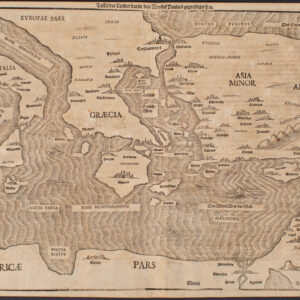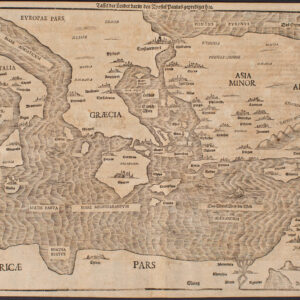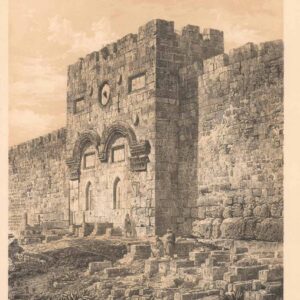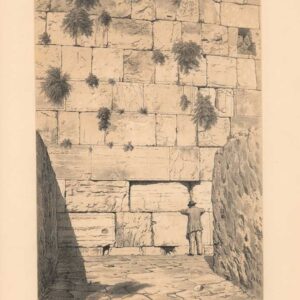A French take on the Levant, twenty years before the expedition that initiated France’s colonial interest in the region.
Carte de la Syrie, l’Asie Mineure et de la Basse Égypte, extraite de d’une carte de l’empire Ottoman en 12 flles.
$400
In stock
Description
Royal Geographer Adrien Hubert Brué compiled this wonderfully detailed map of the Greater Levant in the 1830s based on a sizable Ottoman wall map of the Great Turkish Empire. It captures the Biblical lands and beyond, but more than that, it represents France’s spiring colonial interest in this region. The map shows the East Mediterranean Basin, including the coastal zone that today constitutes Israel, Palestine, and Lebanon. Cyprus, Upper Egypt (i.e., the Nile Delta and northern Sinai), and a significant portion of the Anatolian Plateau are also depicted in similar detail.
The map is very well-executed, with both topography and the level and range of cartographic accuracy remaining impressive. Cities, towns, and villages are clearly marked, as are roads, railroads, and other infrastructure. The dramatic topography of this landscape is palpably recognizable from the Biblical narrative. In unison, all these features serve to accentuate the oriental mystique of these ancient lands.
As if to underline the shifting political affiliations, Brué has included a small inset map of the sea southwest of Cyprus, which shows the nexus of the European, African, and Asian landmasses. Extant political configurations have been sketched, from India and Mongolia in the east to Sahel and Iberia in the west. The inset denotes not only Europe’s growing colonial possessions worldwide but also the fragmentation of the Islamic world into fiefs and kingdoms. Brué saw to it that the map was hand-colored to delineate such political divisions. However, his real goal in this particular map was to show the increased political fragmentation of the Ottoman Empire during the 19th century. Thus, we see Anatolia as separate from the Levant and Egypt, distinct from Mesopotamia (i.e. Syria and Iraq).
In many ways, this political disintegration fueled France’s colonial interest in the region. At the same time, France did not make its colonial aspirations known until the now famous Lebanon-Syria Expedition (1860-61). It did so by systematically mapping the entire North Levant in great detail. Despite this endeavor being twenty years into the future when our map was published, French interests can already be seen in the subdivision of Lebanon- and Anti-Lebanon Mountain Ranges into four distinct sectors, each of which has been provided with a different color border. It is no coincidence that these would become the exact regions in which France first would make its colonial presence felt.
Context is Everything
Adrien-Hubert Brué was a Royal Geographer during the so-called July Monarchy (1830-1848), during which Louis Philippe I reigned as King of France. This period of relative calm followed the massive social upheavals of the French Revolution and the subsequent Napoleonic Wars.
As geographer to the King, Brué produced several important maps and charts. Still, his most successful endeavor was the Atlas universel de géographie physique, politique, ancienne et moderne, from which this map derives. The original edition of the expanded atlas was issued in 1830, but a decade later, a second and enlarged edition was published. This edition saw several significant changes made to many of the maps inside – especially about the political configuration of North America. Our map of the East Mediterranean comes from this enlarged second edition of the atlas.
Census
The map was published in the second and enlarged edition of Brué’s Atlas universel de géographie physique, politique, ancienne et moderne, published in Paris in 1840. This edition of the atlas included 68 engraved maps, of which 67 were double-page sheets. The current Levant map is, in other words, the only single-page map in the atlas.
Brué’s maps were drawn directly onto the copper printing plates, and most of the sheets were subsequently hand-colored in outline. The atlas covered both contemporary and historical geography, including maps of Alexander the Great’s Empire or the Route of Exodus. It was published multiple times and in different versions between 1820 and 1875, with the first enlarged version being issued in 1840. Our map derives from this enlarged edition.
Cartographer(s):
Adrien Hubert Brué (1786-1832) was a French cartographer active in the 18th and 19th centuries. He was born in Paris on March 20, 1786, and died of cholera on July 16, 1832, in Sceaux.
In his youth, Brué served as a cabin boy on various ships, including aboard the Naturaliste, which was part of the Baudin expedition (1800-1804) to the South Seas and New Holland (Australia). Upon his return, he began producing maps for a grand atlas, published for the first time in 1820. A new and better atlas was issued in 1830, the same year he was appointed Royal Geographer.
Brué’s production included various atlases and unique maps, all of which were recognized for the purity of the engraving and the accuracy of the information. His main work, the Atlas universel was expanded multiple by him and Charles Picquet (whose stamp is found on most of Brué’s maps). Among the many aspects that elevated Brué above his peers was the. The fact that he drew his maps directly onto copper plates, a process which he named cartel end prototypes.
Chez Charles PiquetChez Charles Piquet was a notable map publishing house in Paris during the 19th century. Charles Piquet, the founder, was a prominent French geographer and cartographer. The publishing house gained distinction for producing high-quality and detailed maps, often focusing on the city of Paris and its surroundings. These maps were known for their accuracy, detail, and artistic merit.
During the 19th century, the field of cartography was evolving with the advancement of surveying techniques and the increasing demand for precise and reliable maps for navigation, urban planning, and military purposes. Piquet’s maps played a significant role in meeting these needs, offering a valuable resource for understanding the geography and urban development of Paris during that era.
Piquet’s work was particularly important in the context of the transformation of Paris under Baron Haussmann in the mid-to-late 19th century, which saw extensive urban renewal and restructuring. Maps produced by Chez Charles Piquet would have provided contemporary and subsequent viewers with an intricate understanding of the city’s layout, streets, and neighborhoods, both before and after Haussmann’s renovations.
Condition Description
Mild toning on left side.
References




